GROUNDHOG DAY: Revisiting The Timeless Classic On Its 25th Anniversary
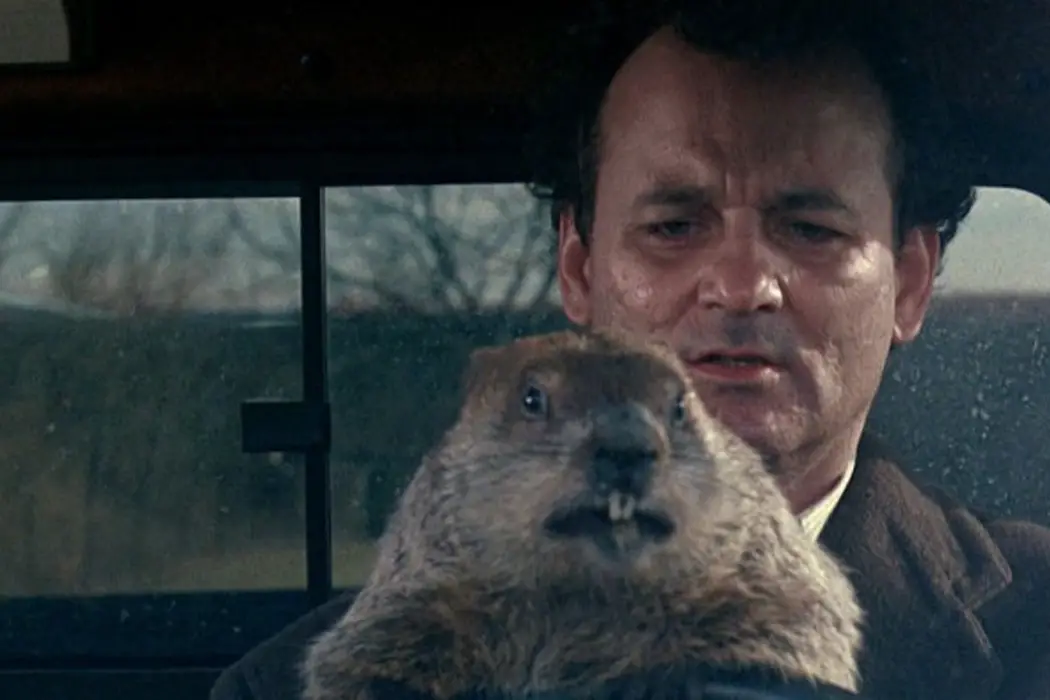
David is a film aficionado from Colchester, Connecticut. He enjoys…
When Groundhog Day first premiered in February of 1993, I was but a young tyke. I don’t remember much that I watched from that time outside of the latest Disney offering or early morning PBS shows, yet there was still something that resonated with me about it. Years later, I revisited the film, and fell in love with it once again.
There’s a lot that’s special about the late-great Harold Ramis‘ comedy classic; whether it be its jaunty sense of humor, the charismatic central performance by Bill Murray, or its strong moral lesson about doing good for the sake of others. Far from being just a farcical comedy, it also manages to be a potent romance and a nihilistically hopeful outlook on life.
In this retrospective, I will examine the film itself, its resounding themes, and the legacy that has endured after 25 years. So, like Phil Connors stuck in his time loop, come experience Groundhog Day…again!
The Story
Groundhog Day concerns Phil Connors (Bill Murray), an egotistical weatherman who works for Channel 9 in Pittsburgh, Pennsylvania. He is assigned, along with cameraman Larry (Chris Elliott) and producer Rita Hanson (Andie MacDowell), to cover the annual Punxsutawney Phil Groundhog Day celebration. The day proceeds with few mishaps, other than being unable to leave the town that night due to a snowstorm. But, upon waking up the next morning, Phil is horrified to discover that something is amiss: the day has repeated itself, and he seems to be the only one aware of it. He first tries to explain it as some strange dream or déjà vu, but the next day, it happens again. Phil is then forced to deal with an unfortunate reality: he is trapped in a time loop, and there’s nothing he can do about it.
What first works so well about Groundhog Day is the way it uses what could easily be a gimmick to drive its story. Danny Rubin’s screenplay, and Ramis‘ direction both embrace the film’s repetitious nature, finding humor in the idea of an irritable man being forced to live through the same day. The humor first comes from the repeated daily annoyances he experiences, such as being awakened by Sonny and Cher’s “I Got You Babe,” being greeted by a smiling man in the hallway (Ken Hudson Campbell), encountering the talkative Mrs Lancaster (Angela Paton) at breakfast, and, of course, the quirkily obnoxious Ned Ryerson (a scene-stealing Stephen Tobolowsky), a man that Phil used to know in high school that frequently interrupts his morning walk to the Groundhog Day ceremony (“PHIL?!”).
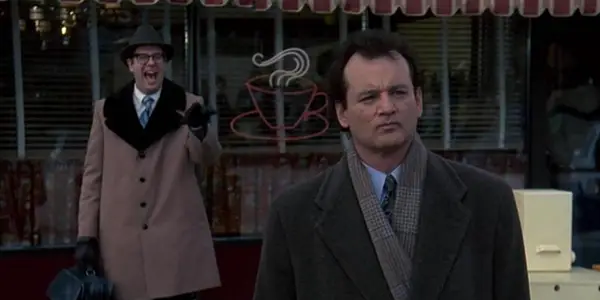
Though angered in the first few days, Phil soon discovers something: if there were no tomorrow, as he asks a drunken local at one point, then “there would be no consequences. There would be no hangovers. We could do whatever we wanted!” And so he proceeds to do just that.
Some of the funnier sequences then follow, including a wild police chase across train tracks, a robbery with precision timing from the back of a money transport truck, a deceptive hookup from the beautiful Nancy Taylor (Marita Geraghty), and much more. Phil soon centers in on his main objective, though: Rita. Through a series of trial-and-errors, he eventually manufactures the perfect day in the hopes of winning her affections by the end of it. With endless do-overs, even the slightest mishap can simply be erased by waiting until the day resets itself.
But Rita won’t be so easily swindled. At the end of each day, she always discovers the deception, resulting in a series of slaps for Phil’s incessant attempts. The inability to fully win Rita over results in him becoming increasingly depressed, with the day’s monotony no longer being exciting as it once was. This results in suicide attempts in order to free himself from the loop (including a hilarious and ultimately deadly chase with Phil the groundhog seated in the passenger seat). Yet, after realizing that even suicide doesn’t stay permanent, Phil turns a corner: what if he is able to change his life, and who he is? Could he be a better person if he puts forth the effort?
The Characters and Town
The initial difficulty of presenting Phil Connors in Groundhog Day is that, despite his obnoxiousness, he still had to be at least somewhat likable given the film’s comedic nature. For this reason, it’s hard to imagine the role being played by anyone other than the sarcastically witty Bill Murray. Even during the opening scene, when Phil gives a weather report in an unusual way, Murray gives the character the requisite charm. Many of the film’s most memorable moments were also improvised by Murray, such as what he says when he gives a long, extended hug to Tobolowsky’s character, or the film’s closing line.
As Groundhog Day progresses, Murray is given an even greater task than just showing his comedic chops, as he has to also carry the weight of Phil’s endless time loops, showing his eventual progression from elation at its prospect to downtrodden at being unable to escape from it. And finally, emerging from this, Murray comes full circle, becoming both charming and happy, even with Phil believing that he will never emerge from being stuck on that day.
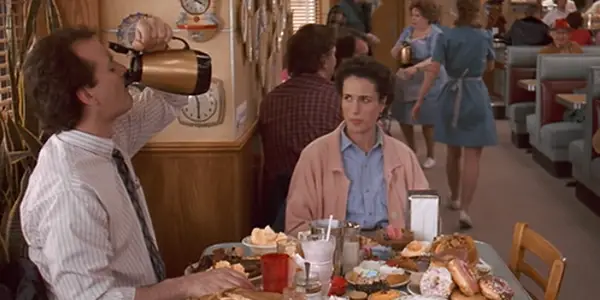
Andie MacDowell is the film’s additional standout performance as Rita. As an antithesis to Phil’s irritating demeanor at the start, she is warm, kind, and full of beaming life. She is, essentially, who Phil wishes he could be. MacDowell gives the character well-rounded personality and grace, also sharing a chemistry with Murray that makes the film’s eventual romantic connection feel more than deserved. As with Murray, it’s hard to imagine the character being played by anyone other than her.
The town of Punxsutawney is also hugely important in Groundhog Day. It’s poetic justice that Phil Connors, a person who seemingly hates anyone cheery, has landed in a town where bright, smiling people are there to greet you at every corner. Other than the aforementioned Mrs. Lancaster and Ned, there is also the lovable town drunk duo of Gus (Rick Ducommun) and Ralph (Rick Overton), friendly Doris the waitress (Robin Duke), jolly groundhog honcho Buster (Brian Doyle-Murray), and more that we see frequently throughout the film. Also, keep an eye out for a young Michael Shannon, only 19 years old at the time, who plays a young hopeful lover named Fred. These characters are scattered throughout the film at various points, acting as the heartbeat for the film and also filling it with a sense of familiarity so common in small communities.
Themes
The premise of Groundhog Day is ripe for simply an irreverent and wacky Ramis/Murray comedy. Ramis has even stated that they “never intended it to be anything more than a good, heartfelt, entertaining story.” But, though it clearly succeeds at this, it’s also much more profound than it initially might appear.
Phil Connors has an “everyman” quality. He’s annoyed with his job and unexcited about his daily life. When he becomes trapped in a time loop, this soon becomes even more evident. At the start of his plight, he asks the following phrase to a town local: “What would you do if you were stuck in one place, and everyday was exactly the same, and nothing you did mattered?” The man’s response: “That about sums it up for me.”
Though Phil’s situation could seem like a type of purgatory, I think of it more as a representation of how many people ultimately see their own routinal lives. It’s analogous to an unremarkable 9-5 working day – one day blends into another, and we all feel like we are just going through the motions: wake up, go to work, come home, go to bed; wake up, go to work, come home, go to bed. It’s easy to be disillusioned with life when you feel trapped in monotony.
Such an aspect also fits in quite well with the idea of existential nihilism. Like Sisyphus pushing his boulder up a mountain, nothing Phil does matters, and any effort he exerts will be undone by the time the day is over. So then why go through the motions at all? What could possibly be enough to inspire someone to live the same unremarkable day over and over and over again?
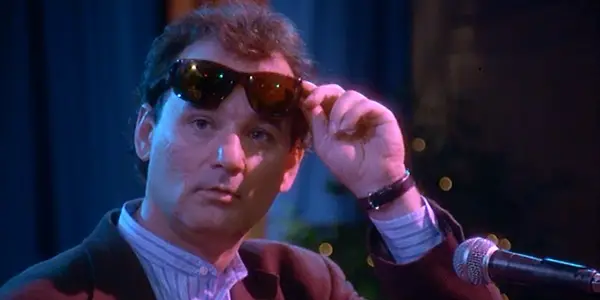
Groundhog Day thankfully presents us with a light at the end of the tunnel. Once Phil realizes that he cannot escape from his situation, even by killing himself, he decides to ask Rita her advice (after convincing her, through a series of questions that he would never know otherwise, that it is really happening). She responds by telling him “I wish I had a thousand lifetimes. Maybe it’s not a curse, Phil. It all just depends on how you look at it.”
So, the next day, Phil starts anew. He helps out his coworkers at his job, is nicer to people he passes on the street, and over subsequent days and weeks learns French, how to play the piano, and how to create elaborate ice sculptures. In one of the more solemn scenes in the film, Phil also encounters an old man on the street, who he had tried to help earlier in the day. The man, who does not speak a word, is entirely alone, and nobody passing seems to pay him any attention. He soon collapses, and later dies at a hospital. Phil is saddened by the news, and in subsequent days attempts to save the old man, to no avail. It’s at this juncture that he discovers something pivotal about the nature of mortality.
Phil, like all of us, realizes in that moment that he will one day be that old man. But perhaps, just as Scrooge discovers in A Christmas Carol, he doesn’t have to be alone and forgotten. He then reaches out even further, connecting with people while utilizing his knowledge of everything that will happen in Punxsutawney on that day. His daily routine soon consists of: saving a boy who falls out of a tree, helping three old ladies with a flat tire, saving a man who is choking, and much more.
By the end of the day, Phil is such a dynamic and lovable force that he is the first to be auctioned off at the charity bachelor auction at the Groundhog Day dance. And Rita, recognizing who Phil has finally become, buys him there for $339.88. As opposed to winning her affections through deception as he had earlier attempted, Phil has instead earned it through sincerity. Through rigorous trials and effort, he is, finally, the person he had hoped to be when he had his earlier epiphany.
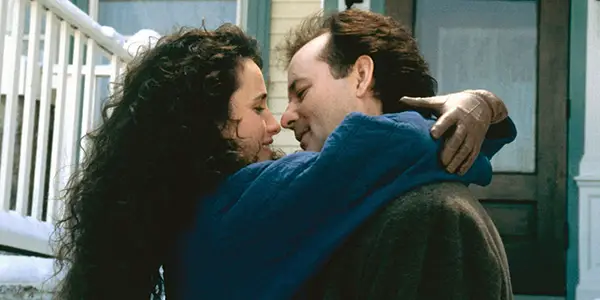
As a bookend to his earlier statement, one of the last things Phil says to Rita before the end of the day is “No matter what happens tomorrow, or for the rest of my life, I’m happy now because I love you.” He has learned to become one with the curse, despite the fleeting nature of this individual moment. Fittingly, it is the very next day that the time loop has ended. Phil is released, and free to live a life that he now knows he wants to be a part of.
It may sound as if the entire film was simply a way to bring two people together, but Groundhog Day is really about love in general. People can look at life cynically, realizing that we all end up in the same place anyways. But through the perspective of the film, the only way to find true, lasting contentment is to love and to give to others, along the way helping to make the world a better place than when you found it. As an example, look at the man who approaches Phil in the hallway every morning: after Phil hugs and greets him with a line from a poem, the man walks off with his head held high and a great big smile on his face. Phil has, through this concerted yet still minuscule effort, made that man’s day just a little bit brighter.
Interestingly, soon after its release, Ramis was receiving letters from people of various theologies, all claiming that the film spoke to their beliefs, including Buddhists, Jews, and Christians, and even from those with no particular religious background. Regardless of your religious doctrine, it’s a film that most people will see at least a part of themselves in, as a way of glancing at our own life’s disillusionment on screen, but then also, through Phil Connors’ arc, seeing the chance to be something more. We may not have quite as much time as Phil does in the film (by some estimates, he was trapped in the time loop for upwards of 10,000 years), but we still have more than we need.
Legacy
The idea of time loops was not a new thing in 1993, with it being seen in film as far back as 1933’s Turn Back the Clock. But perhaps never before had it been so prominent and therefore propelled in the public consciousness before Groundhog Day. The film has subsequently lent its influence to many films and TV shows to follow, including Edge of Tomorrow, Source Code, episodes of The X-Files and Buffy the Vampire Slayer, and even just this past year with the films Before I Fall and Happy Death Day. In Happy Death Day, they even expressly acknowledge this influence in the film’s closing scene.
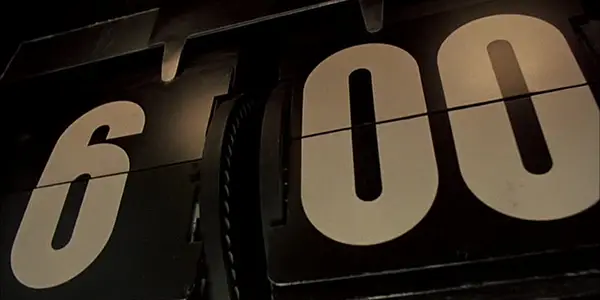
In addition, the phrase “Groundhog Day” has come to mean the idea of being trapped in a day or an event that constantly repeats itself, including a popular use in the military. Every year on February 2nd, thousands of people gather to hold related events, including in Woodstock, Illinois where the film was shot and, of course, even larger crowds in Punxsutawney, Pennsylvania. And you can be sure that Groundhog Day the movie will have some bearing on these celebrations. Over the years, it has become a film that, much like It’s a Wonderful Life for Christmas or Planes, Trains, and Automobiles for Thanksgiving, has become synonymous with the day itself. Perhaps fittingly, it’s also a movie that I have likely watched more than any other.
Conclusion: Groundhog Day
It’s hard to believe that it’s been 25 years since Groundhog Day first emerged. Since then, we have unfortunately lost the great Harold Ramis, but his film’s enduring quality lives on. Its humor, tender performances, sincerity, and feel-good ending are just as impactful as the raw existential statement that it provides about how to find true happiness.
On February 2nd, as I do every year, I eagerly anticipate watching Groundhog Day yet again. And basking in the warmth of this heartfelt and wonderful film, I couldn’t imagine a better fate than a long and lustrous winter
What are your thoughts on Groundhog Day? Let us know in the comments below!
Does content like this matter to you?
Become a Member and support film journalism. Unlock access to all of Film Inquiry`s great articles. Join a community of like-minded readers who are passionate about cinema - get access to our private members Network, give back to independent filmmakers, and more.
David is a film aficionado from Colchester, Connecticut. He enjoys writing, reading, analyzing, and of course, watching movies. His favorite genres are westerns, crime dramas, horror, and sci-fis. He also enjoys binge-watching TV shows on Netflix.













